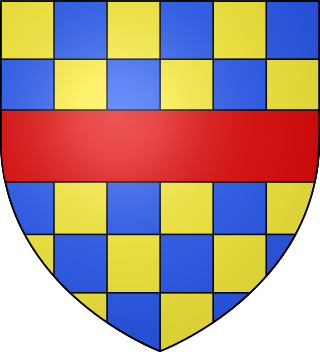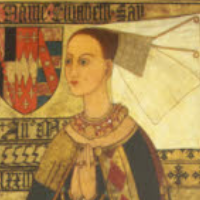Related Research Articles

Henry Percy, 3rd Earl of Northumberland, was an English magnate.
The Percy–Neville feud was a series of skirmishes, raids, and vandalism between two prominent northern English families, the House of Percy and the House of Neville, and their followers, that helped provoke the Wars of the Roses. The original reason for the long dispute is unknown, and the first outbreaks of violence were in the 1450s, prior to the Wars of the Roses. The antagonists would later meet in battle several times during the feud.
Sir Thomas Tresham was a British politician, soldier and administrator. He was the son of Sir William Tresham and his wife Isabel de Vaux, daughter of Sir William Vaux of Harrowden. Thomas's early advancement was due to his father's influence. In 1443 he and his father were appointed as stewards to the Duchy of Lancaster's estates in Northamptonshire, Buckinghamshire, Bedfordshire and Huntingdonshire, and by 1446 Thomas was serving as an esquire for Henry VI, being made an usher of the king's chamber in 1455. He was appointed a Justice of the Peace for Huntingdonshire in 1446, a position he held until 1459, and was returned to Parliament for Buckinghamshire in 1447 and Huntingdonshire in 1449. Despite the Tresham family's close links with the royal court they were also on good terms with Richard Plantagenet, 3rd Duke of York, and when he returned from Ireland in 1450 Tresham and his father went to greet him. Shortly after leaving home on 23 September they were attacked by a group of men involved in a property dispute with his father; William Tresham was killed, and Thomas was injured.
Sir John Say was an English courtier, MP and Speaker of the House of Commons.

John Clifford, 9th Baron Clifford, 9th Lord of Skipton was a Lancastrian military leader during the Wars of the Roses in England. The Clifford family was one of the most prominent families among the northern English nobility of the fifteenth century, and by the marriages of his sisters, John Clifford had links to some very important families of the time, including the earls of Devon. He was orphaned at twenty years of age when his father was slain by partisans of the House of York at the first battle of the Wars of the Roses, the Battle of St Albans in 1455. It was probably as a result of his father's death there that Clifford became one of the strongest supporters of Margaret of Anjou, wife of King Henry VI, who ended up as effective leader of the Lancastrian faction.
John Neville, Baron Neville was an English nobleman who fought for the House of Lancaster during the Wars of the Roses. He belonged to a senior but impoverished branch of the Neville family of northern England, which had earlier been disinherited in favour of a younger branch headed by John's half–uncle, Richard, Earl of Salisbury. John Neville and his brothers spent several years feuding with Salisbury over the contested inheritance and, when the dynastic wars broke out, John sided with the Lancastrians whilst the junior Nevilles sided with the House of York.

John Talbot, 2nd Earl of Shrewsbury, 2nd Earl of Waterford, 8th Baron Talbot, KG was an English nobleman and soldier. He was the son of John Talbot, 1st Earl of Shrewsbury, 1st Earl of Waterford, 7th Baron Talbot, 10th Baron Strange of Blackmere, and Maud Neville, 6th Baroness Furnivall.

John Wenlock, 1st Baron Wenlock was an English politician, diplomat, soldier and courtier. He fought on the sides of both the Yorkists and the Lancastrians in the Wars of the Roses. He has been called "the prince of turncoats", although some historians suggest the label may not be fair as this behavior was commonplace during the Wars of the Roses. Others contend that even when Wenlock was not actually changing sides, he was engaged in "fence sitting par excellence."

Walter Devereux, 8th Baron Ferrers of Chartley, KG was an English nobleman and a loyal supporter of the House of York during the Wars of the Roses. He was a member of the inner circle of King Edward IV, and died fighting for Edward's younger brother, King Richard III, at the Battle of Bosworth in 1485.

The King's Wardrobe, together with the Chamber, made up the personal part of medieval English government known as the King's household. Originally the room where the king's clothes, armour, and treasure were stored, the term was expanded to describe both its contents and the department of clerks who ran it. Early in the reign of Henry III the Wardrobe emerged out of the fragmentation of the Curia Regis to become the chief administrative and accounting department of the Household. The Wardrobe received regular block grants from the Exchequer for much of its history; in addition, however, the wardrobe treasure of gold and jewels enabled the king to make secret and rapid payments to fund his diplomatic and military operations, and for a time, in the 13th-14th centuries, it eclipsed the Exchequer as the chief spending department of central government.
Events from the 1450s in England.
Sir Thomas Browne was a Member of Parliament and Chancellor of the Exchequer. Browne's tenure as Chancellor occurred during the Great Bullion Famine and the Great Slump in England. He was executed for treason on 20 July 1460.
Thomas Charlton (1417?–1465) was a speaker for House of Commons of England in 1454.

Sir James Strangeways was Speaker of the House of Commons of England between 1461–1462. and a close political ally of Edward IV's Yorkist faction.
Sir John Wood was Speaker of the House of Commons of England between January 1483 and February 1483.

Elizabeth Cheney was a member of the English gentry, who, by her two marriages, was the great-grandmother of Anne Boleyn, Jane Seymour, and Catherine Howard, three of the wives of King Henry VIII of England, thus making her great-great-grandmother to King Edward VI, the son of Henry VIII and Jane Seymour, and Elizabeth I, the daughter of Henry VIII and Anne Boleyn. Her first husband was Sir Frederick Tilney, and her second husband was Sir John Say, Speaker of the House of Commons. She bore a total of eight children from both marriages.

Robert Hungerford, 3rd Baron Hungerford was an English nobleman. He supported the Lancastrian cause in the War of the Roses. In the late 1440s and early 1450s he was a member of successive parliaments. He was a prisoner of the French for much of the 1450s until his mother arranged a payment of a 7,966l ransom. In 1461, after defeat on the Towton battlefield on 29 March, he fled with Henry VI to Scotland. In 1461 he was attainted in Edward IV's first parliament, and executed in Newcastle soon after he was captured at the Battle of Hexham.
Thomas de la More was a fifteenth-century Sheriff of Cumberland. Little is known of his early life, but he was a loyal royal official in Cumberland and Westmorland for all his adult life, serving as Member of Parliament, Escheator and Justice of the Peace on multiple occasions. A man of social and political significance in the area, he eventually became involved in the struggle for local supremacy in the 1450s between the Neville and Percy families. This led to him and his men being beaten and threatened by Thomas Percy, Lord Egremont, over which he petitioned the royal council in 1455. De la More played no active part in the Wars of the Roses which broke out the same year. He is known to have married twice. His first wife, called either Idione or Maud, died first, but his second, Margaret, survived him.

John Beaumont, 1st Viscount Beaumont, was an English nobleman and magnate from Folkingham, Lincolnshire. He was a councillor to King Henry VI and was rewarded for his services, becoming a leading member of the East Anglian nobility. Beaumont held numerous offices for the crown, and was promoted up the peerage to become the first man with the rank of viscount. He also amassed immense personal wealth, acquired through inheritance, marriage, and royal patronage.
Sir Thomas Neville was the second son of Richard Neville, 5th Earl of Salisbury, a major nobleman and magnate in the north of England during the fifteenth-century Wars of the Roses, and a younger brother to the more famous Richard Neville, Earl of Warwick, the 'Kingmaker'. Thomas worked closely with them both in administering the region for the Crown, and became a significant player in the turbulent regional politics of northern England in the early 1450s, especially in the Neville family's growing local rivalry with the House of Percy. His wedding in August 1453 is said to have marked the beginning of the armed feud between both houses, in which Thomas and his brother John led a series of raids, ambushes and skirmishes across Yorkshire against the Percy family. Historians describe the feud as setting the stage for the Wars of the Roses, the dynastic struggle between the houses of Lancaster and York for the English throne, and Thomas played a large role in the Neville family's alliance with his uncle, Richard, Duke of York.
References
This article includes a list of general references, but it lacks sufficient corresponding inline citations .(May 2014) |
- Summerson, Henry. "Thorpe, Thomas". Oxford Dictionary of National Biography (online ed.). Oxford University Press. doi:10.1093/ref:odnb/27384.(Subscription or UK public library membership required.)
- The Office of Speaker, by Philip Laundy (Cassell & Company, 1964)
- Parliament and politics in late medieval England, Volume 2 p. 175 et seq By John Smith Roskell
